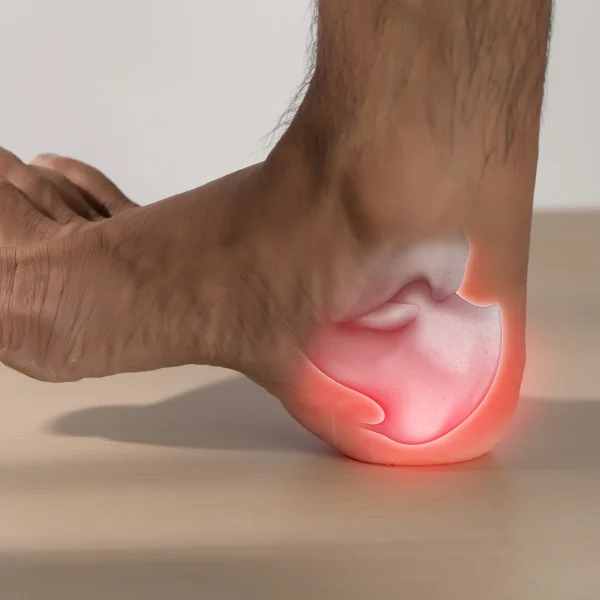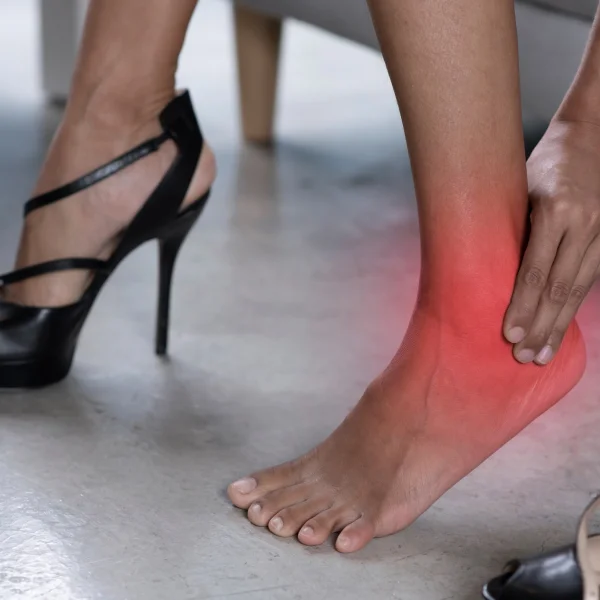
Have you ever felt that nagging pain in your heel that prevents you from walking comfortably? Heel pain is a common problem that can significantly affect your quality of life. In this article, we will explore in depth the causes and solutions for this podiatric condition. But before diving into the details, did you know that the Clinique Podiatrique de Chomedey offers a complete range of beauty products for your feet? Visit their website to discover how to combine foot health and aesthetics!
Heel pain, also known as talalgia, is a painful condition that affects the posterior part of the foot. This pain can range from mild discomfort to intense pain, sometimes making walking difficult. Heel pain can occur suddenly or develop gradually over time.

Understanding the root causes of heel pain is crucial for effective treatment and prevention. Each cause has its unique characteristics and requires specific approaches for management. Let’s delve into the most common culprits behind heel discomfort:
This is one of the most common causes of heel pain. It is characterized by inflammation of the plantar fascia, a band of tissue that connects the heel to the toes. The pain is often most intense with the first steps in the morning or after periods of rest. Overpronation, high arches, or flat feet can increase the risk of developing this condition.
This bony growth on the heel can cause persistent heel pain, especially when walking or running. Heel spurs often develop as a result of long-standing plantar fasciitis. They’re visible on X-rays and can grow up to half an inch in length.
Inflammation of the Achilles tendon can cause pain at the back of the heel. This condition is common among runners and athletes who suddenly increase their training intensity. The pain may be accompanied by stiffness and swelling in the affected area.
Inflammation of the small fluid-filled sacs (bursae) around the heel can lead to heel pain. Bursitis can result from repetitive motion or excessive pressure on the heel. The pain may worsen when standing on tiptoes or when the area is touched.
A microscopic crack in the heel bone can cause intense pain. These fractures often result from overuse, particularly in high-impact sports. The pain typically increases with activity and decreases with rest.
Compression of the tibial nerve can cause pain that radiates to the heel. This condition can cause burning, tingling, or numbness that extends from the inside of the ankle to the heel and sole. It’s similar to carpal tunnel syndrome but affects the foot instead of the wrist.
Various forms of arthritis can affect the ankle joint and cause heel pain. Osteoarthritis, rheumatoid arthritis, and gout are common types that can impact the heel. Pain may be accompanied by stiffness, particularly in the morning or after periods of inactivity.

Certain factors can increase your risk of developing heel pain:
To avoid heel pain or prevent its recurrence, here are some tips:
If your heel pain persists despite self-care measures, it’s time to consult a professional. A podiatrist can:
Heel pain can have many causes, and an accurate diagnosis is essential for effective treatment. A podiatrist will use various techniques to identify the origin of your pain:
This information will allow for the development of a targeted treatment plan to relieve your heel pain.
Modern podiatry offers innovative solutions to treat heel pain:
Heel pain can significantly affect your daily life:
This is why it’s crucial to treat heel pain quickly and effectively.
Heel pain is a painful condition that can greatly affect your quality of life, but with proper care and treatment, it’s possible to regain comfort and mobility. Remember that prevention and early diagnosis are essential to prevent heel pain from becoming chronic.
For quality podiatric care and personalized advice, don’t hesitate to visit the Clinique Podiatrique de Chomedey. In addition to their medical expertise, they offer a range of beauty products specially designed to take care of your feet. Make an appointment today and take the first step towards healthy, pain-free feet!